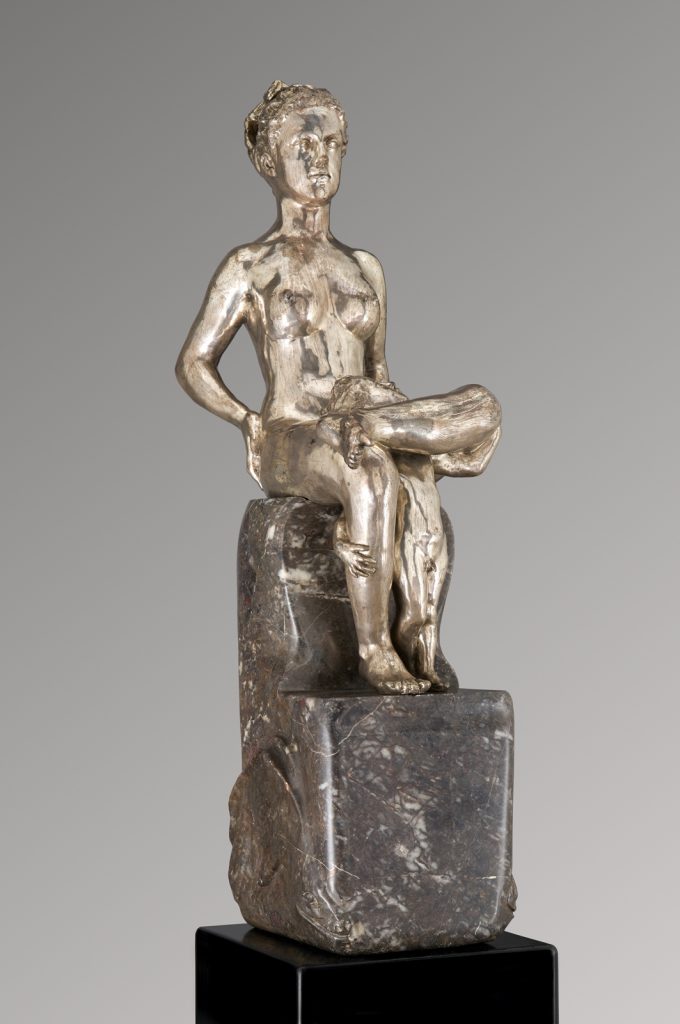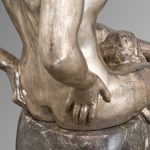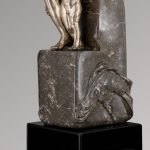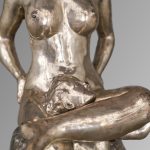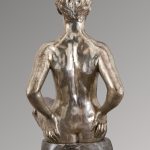Max Klinger
(Leipzig 1857 - 1920 Großjena near Naumburg)
Galatea, 1906
Cast silver, 80 x 31 x 34 cm;
marble base, 55.7 x 27 x 34 cm;
total height 111.5 cm
Sold to the Metropolitan Museum of Art, New York.
Provenance:
Max Klinger
Gustav and Clara Kirstein collection, Leipzig, purchased 1909
On loan to the Museum der bildenden Künste, Leipzig (since 1927)
Restitution of the Museum der bildenden Künste, Leipzig, to the Kirsteins’ heirs,
25 September 2000[1]
(Via the executor of Clara Kirstein’s estate, the statuette ended up, presumably in 1939, with the art dealer C.G. Boerner and was acquired by the Dresden art collector Paul Geipel, who donated the work to the Leipzig museum in 1956. However, the statue of Galatea probably remained in the museum in Leipzig the whole time, since it is not recorded in the inventory of the Paul Geipel Foundation.[2])
Sotheby’s London, 2001
Siegfried Unterberger collection, Meran
On loan to the Museum der bildenden Künste, Leipzig, 2004-2006
Exhibited:
Dritte Deutsche Künstlerbundausstellung, Großherzogliches Museum für Kunst und Kunstgewerbe, Weimar, June 1906, cat. no. 321 (Galathee [Silbergruppe]).
Sonderausstellung zur Feier des fünfzigjährigen Geburtstages von Max Klinger. Skulpturen, Gemälde, Zeichnungen, Radierungen, Ätzungen, Leipziger Kunstverein 1907, cat. no. 12
Ein Überblick über das gesamte bisherige Schaffen Max Klingers an ausgewählten Gemälden, graphischen und plastischen Hauptwerken seiner Hand zusammengestellt im Frankfurter Kunstverein, Frankfurt am Main 1908, cat. no. 117
Max Klinger, Siebzehnte Ausstellung der Berliner Sezession, Berlin 1909, cat. no. 8 (as Nereide)
Europäische Kunst um die Jahrhundertwende, Haus der Kunst, Munich 1964, cat. no. 925
Max Klinger 1857-1920. Ausstellung zum 50. Todestag des Künstlers, Museum der bildenden Künste Leipzig 1970, cat. no. 16
Europa 1900. Peintures – Dessins – Sculptures – Bijoux, Musée des Beaux-Arts Ostend 1967, cat. no. 191
Stilkunst um 1900 in Deutschland, Nationalgalerie, Berlin 1972, cat. no. 97, fig. 126
Max Klinger 1857-1920. Malerei, Graphik, Plastik. Werke aus dem Besitz des Museums der bildenden Künste Leipzig und der Graphischen Sammlung Albertina Wien, Vienna Künstlerhaus 1981, no. 12
Max Klinger 1857-1920, Städelsches Kunstinstitut Frankfurt am Main, Von der Heydt Museum Wuppertal 1992, cat. no. 286
Max Klinger 1857-1920, Werke aus der Sammlung Siegfried Unterberger, Goethe Galerie Bolzano 2002, p. 34
Max Klinger. Von der herben Zartheit schöner Formen. Gemälde, Zeichnungen, Radierungen, Skulpturen aus der Sammlung von Siegfried Unterberger und aus Museen Thüringens und Sachsens, exhib. cat. Apolda, Kunsthaus Apolda Avantgarde, Duisburg, Wilhelm-Lehmbruck-Museum, Apolda 2010
Max Klinger: ... und ewig lockt das Weib. Werke aus der Sammlung Siegfried Unterberger und dem Museum der bildenden Künste Leipzig, Klinger Villa, Leipzig 2011
Literature:
‘Ein neues Werk von Max Klinger. 3 Abbildungen der Silberstatuette "Galathea"’, in Zeitschrift für Bildende Kunst, vol. 17, 1905/1906, p. 286
Max Osborn, ‘Der Deutsche Künstlerbund in Weimar’, in Der Kunstwart, vol. 20, 1907, 2nd October issue, 1906, p. 108
Paul Kühn, Max Klinger, Leipzig 1907, p. 443
Hildegard Heyne, Max Klinger im Rahmen der modernen Weltanschauung und Kunst. Leitfaden zum Verständnis Klinger’scher Werke, Leipzig 1907, p. 60
Münchner illustrierte Wochenschrift für Kunst und Leben, vol. 7, 1907, repr. p. 149
Julius Vogel, ‘Max Klinger. Ein Rückblick und ein Ausblick’, in Die Kunst für alle: Malerei, Plastik, Graphik, Architektur, no. 14, 15 April 1909, pp. 337-338, no. 13, 1 April 1909, ill. p. 311
Max Schmid, Max Klinger, expanded edition, Bielefeld, Leipzig 1913, fig. 113, p. 130
Max Schmid and Julius Vogel, Max Klinger, Bielefeld 1926, pp. 148-149, fig. 126
Max Klinger. Bestandskatalog der Bildwerke, Gemälde und Zeichnungen im Museum der bildenden Künste Leipzig, Leipzig 1995, p. 75, fig. 132
Andreas Priever and Karl-Heinz Mehnert, Max Klinger, Plastische Meisterwerke, Leipzig 1998, pp. 15-16
Herwig Guratzsch (ed.), Museum der bildenden Künste Leipzig, Katalog der Bildwerke, Cologne 1999, p. 195, no. 462
Koordinierungsstelle für Kulturgüterverluste Magdeburg (ed.), Beiträge öffentlicher Einrichtungen der Bundesrepublik Deutschland zum Umgang mit Kulturgütern aus ehemaligem jüdischen Besitz, Magdeburg 2001, p. 219
[soliloquy id="4480"]
The material aesthetics of Max Klinger’s sculptures – an important aspect of his sculptural work that was already valued by his contemporaries – become apparent only in the presence of the sculpture itself. The art critic Paul Kühn wrote about Klinger’s Galatea in 1907: The dull sheen of the silver, the soft gleam of the broad reflections of light combined with the solemnly grave black of the polished marble – that is yet another revelation of Klinger’s sense of beauty.[3]
A photograph illustrates the excitement caused by Klinger’s Galatea at the Künstlerbund (Artists’ Association) exhibition in Weimar in 1906. Like a cult figurine of antiquity, the silver figure sits in state in the midst of representatives of Weimar’s cultural life: Max Klinger, Henry van der Velde, Harry Graf Kessler, Ludwig von Hofmann and others (fig. 1).
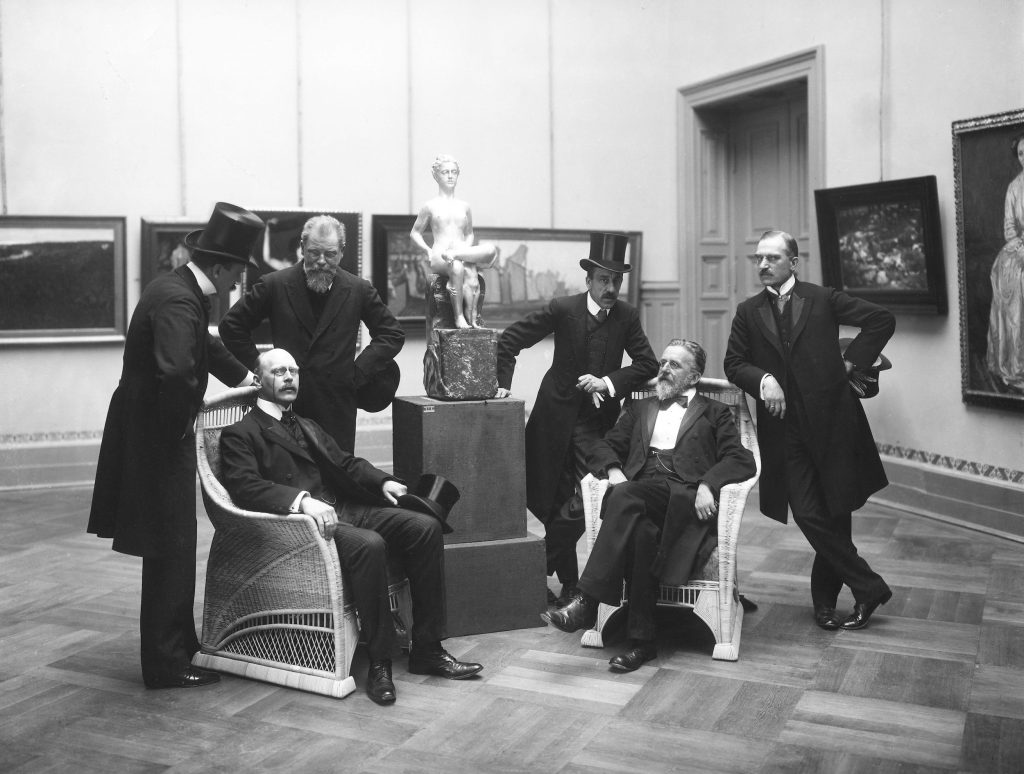
Fig. 1 Galatea in Weimar in 1906, surrounded (from left to right) by Harry Graf Kessler, Ludwig von Hofmann, Max Klinger, Henry van der Velde, Theodor Hagen, Hans Olde
Klinger’s intense engagement with traditional themes and motifs can make his oeuvre look conventional at first glance. Its modernity lies in the artist’s challenge to the viewer to experience his art in an associative, subjective way, as though seeing old myths through the eyes of psychoanalysis. Thus Klinger’s Galatea speaks both of idol worship and the material cult of the pagan world, as well as of inaccessibility, eroticism and Oedipal conflict. The ambivalence of the myth of Galatea, which has been reinterpreted continually from antiquity to the nineteenth century, is therefore well suited to Klinger’s approach.
Galatea both provokes and spurns the love of the Cyclops Polyphemus,[4] son of Poseidon; the result of their union is a son, Galatos.[5] Ovid tells of Galatea’s lover, the handsome shepherd boy Acis, who is killed by his rival Polyphemus. The nymph then turns Acis’ blood into a river, so that she can be reunited with her lover for all eternity.
In the eighteenth and nineteenth centuries, the beautiful Galatea was associated with the famous statue made by the antique sculptor Pygmalion, a statue so beautiful that he fell madly in love with it. Upon his supplications, Aphrodite brought her to life and Pygmalion made her his wife.[6]
The myths both ancient and modern that surround Galatea merged in the art of the nineteenth century and achieved great popularity in the fin de siècle[7] – now with strong erotic connotations that reflect the battle of the sexes raging around 1900: Galatea, as femme fatale, strong, desirable, erotic, unapproachable. Klinger’s fascination for strong women became apparent long before Galatea in his New Salomé of 1887/88 and his Cassandra of 1895. During Klinger’s problematic liaison with the writer Elsa Asenijeff (1867-1941), this type of woman took on biographical traits. Around 1900, the liberated woman was considered a provocative role model by the struggling patriarchy, which sought to give this threat a name – femme fatale – and thereby vanquish it.
It is reasonable to see the boy, held tight between Galatea’s crossed legs, in an Oedipal light. [8] The art historian Werner Hofmann, who places Max Klinger in the same context as Toulouse-Lautrec, Manet, Munch and Cézanne, writes in his seminal essay on nineteenth-century art, Das irdische Paradies (The Earthly Paradise): [The myth of] Oedipus contains yet another motif: the adoring abandon of the man who looks up to a woman. His gaze is a mixture of question and desire, humility and uncertainty. This worship of ‘Virago’ has Romantic origins, ranging from Füssli’s courtesans .... to Klinger’s female figures, the perverse imagination of Felicien Rops, Toulouse-Lautrec’s circus horsewomen and Munch’s Madonna, this devotional image of the Eros of decadence.[9]
Klinger himself writes: Next to the admiration, the worship of this magnificent, wide-ranging world live the resignations, the cold comfort, the whole misery of the absurd triviality of the wretched creature in the never-ending struggle between desire and ability. To feel what he sees, to convey what he feels – that is the artist’s life. Should, then, that which is naturally bound to beauty through form and color remain silent inside him, the powerful impressions whereby the dark side of life inundates him, in the face of which he also seeks help? From the immense contrasts between sought-after, seen, perceived beauty and the awesomeness of existence, which he often glaringly encounters, images must originate, just as they spring from the vivid sensations of the poet, the musician.[10]
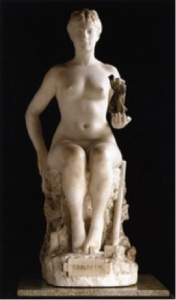
Fig. 2 Jean-Léon Gérôme, Tanagra, 1890, marble, height 154.7 cm, Paris, Musée d'Orsay, inv. no. RF 2514
Klinger stayed repeatedly in Paris, where he certainly saw Jean-Léon Gérôme’s (1824-1904) interpretation of the Galatea motif, as well as his Tanagra, a life-size, polychrome marble statue made in 1890 (fig. 2), whose seated position is derived from the same antique example that Klinger consulted: Phidias’ seated figure of Zeus in Olympia. Comparison with Gérôme’s interpretation, in particular, reveals Klinger’s modernity.
It is not clear when Max Klinger embarked on the statue of Galatea. A study dated December 1903 of a female nude, sitting upright, and another, undated study are directly connected with it.[11] The plaster model now preserved in the Kunstmuseum Leipzig originated in 1905.[12] Related to Galatea in terms of motif and material are centerpieces made by Klinger for the Neues Rathaus (New Town Hall) in Leipzig in 1905, on which occasion he first tackled the material and technical problems involved in silver-casting. On 22 March 1906 the artist wrote to his friend, the Leipzig art collector and publisher Georg Hirzel (1867-1924), with regard to the statue of Galatea: However, I remain here with my figure, which I hope to have finished for Weimar (1 May).[13] In fact, Galatea, cast in the summer of 1906 at Noack & Brückner, Leipzig,[14] was finished just in time for the exhibition finally held by the Weimar Künstlerbund in June.[15]
[1] Cf. Koordinierungsstelle für Kulturgüterverluste Magdeburg (ed.), Beiträge öffentlicher Einrichtungen der Bundesrepublik Deutschland zum Umgang mit Kulturgütern aus ehemaligem jüdischen Besitz, Magdeburg 2001, pp. 236-37.
[2] Cf. Max Klinger 1857-1920, Werke aus der Sammlung Siegfried Unterberger, exhib. cat. Goethe Galerie Bolzano 2002, p. 30.
[3] Paul Kühn, Max Klinger, Leipzig 1907, p. 442: Der matte Glanz des Silbers, der zarte Schimmer der breitflächigen Lichtreflexe in Verbindung mit dem tiefen, feierlich-ernsten Schwarz des polierten Marmors, das ist wieder eine Offenbarung von Klingers Schönheitssinn.’
[4] The one-eyed Cyclops is known from the ninth book of Homer’s Odyssey, in which Odysseus, held captive in Polyphemus’ cave, outwits the Cyclops and blinds him.
[5] Sandrart, among others, states: ‘And Bacchilides says that he conceived with her a son by the name of Galatos’ (Und Bacchilides sagt/ daß er mit ihr einen Sohn/ Namens Galathus/ gezeugt’). Joachim von Sandrart, Teutsche Akademie der Bau-, Bild- und Mahlerey-Künste, Nuremberg 1679, p. 150, http://ta.sandrart.net/-text-1273 (16 June 2016).
[6] The tales surrounding Galatea were broadened by Jean-Jacques Rousseau at the end of the eighteenth century: the sculptor Pygmalion, disappointed by women, falls in love with a statue he had carved, called Galatea in later accounts. At his request, Venus brought the statue to life.
[7] Cf. Gustave Moreau (1826-1898), Galatea, c. 1880, oil on panel, 85.5 x 66 cm, Paris, Musée d'Orsay, inv. no. RF 1997 16. Jean-Léon Gérôme, Pygmalion and Galatea, c. 1890, oil on canvas, 88.9 x 68.6 cm, The Metropolitan Museum, New York, inv. no. 27.200.
[8] Klinger’s sculptural work always provoked contradictory criticism and emotionally charged discussions. This unusual pictorial formulation also contributed to a lack of understanding – arising from a sexual interpretation of the figure – on the part of some of his contemporaries. Cf., among others, Max Osborn, ‘Der Deutsche Künstlerbund in Weimar’, in Der Kunstwart, vol. 20, 1907, 2nd October issue, 1906, p. 108.
[9] Hofmann, Das irdische Paradies ( Klinger cat. p. 10): “Im Ödipus ist noch ein anderes Motiv enthalten: die bewundernde Hingabe des Mannes, der zum Weibe emporblickt. In seinem Blick mischen sich Frage und Begehren, Demut und Ungewissheit. Romantischen Ursprungs ist diese Verehrung der ‘Virago’, sie reicht von Füsslis Kurtisanen (....) bis zu den Frauengestalten Klingers, zur perversen Phantasie des Felicien Rops, zur Zirkusreiterin des Toulouse-Lautrec und zur Madonna von Munch, diesem Andachtsbild des Eros der Decadence.”
[10] Max Klinger, Malerei und Zeichnung, Leipzig 1895, pp. 25-27: Neben der Bewunderung, der Anbetung dieser prachtvollen, großschreitenden Welt, wohnen die Resignationen, der arme Trost, der ganze Jammer der lächerlichen Kleinheit des kläglichen Geschöpfes im ewigen Kampfe zwischen Wollen und Können. Zu empfinden was er sieht, zu geben was er empfindet, macht das Leben des Künstlers aus. Sollten den nun an das Schöne gebunden durch die Form und Farbe, in ihm die mächtigen Eindrücke stumm bleiben, mit denen die dunkele Seite des Lebens ihn überflutet, vor denen er auch nach Hilfe sucht? Aus den ungeheueren Kontrasten zwischen der gesuchten, gesehenen, empfundenen Schönheit und der Furchtbarkeit des Daseins, die schreiend oft ihm begegnet, müssen Bilder entstehen, wie sie dem Dichter, dem Musiker aus der lebendigen Empfindung entspringen.
[11] Cf. exhib. cat. Goethe Galerie Bolzano 2002, op. cit., p. 22.
[12] Cf. Herwig Guratzsch (ed.), Museum der bildenden Künste Leipzig, Katalog der Bildwerke, Cologne 1999, pp. 194-195, cat. no. 461.
[13] Angela Windholz (ed.), Mir tanzt Florenz auch im Kopf rum. Die Villa Romana in den Briefen von Max Klinger an den Verleger Georg Hirzel, Munich, Berlin 2005, letter no. 176, p. 207: “Ich bleibe aber hier bei meiner Figur, die ich bis Weimar fertig zu haben hoffe (1. Mai.).” In letter no. 178 of 5 April 1906, Klinger tells Hirzel about the postponement of the exhibition in Weimar.
[14] There is no foundry mark, because the cast is extremely thin.
[15] The preceding years were dominated by Klinger’s idea of founding a Florentine artists’ colony. On 4 April 1905, Klinger acquired, with funds from his circle of artist friends, a classicist villa in the vicinity of Florence. That same year, the Villa Romana Prize was awarded for the first time as a counter-model to the awards given by the state academies. Cf. Thomas Föhl, Gerda Wendermann (eds.), Ein Arkadien der Moderne? 100 Jahre Künstlerhaus Villa Romana in Florenz, Berlin 2005.

